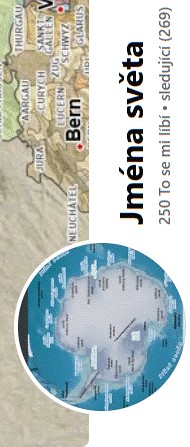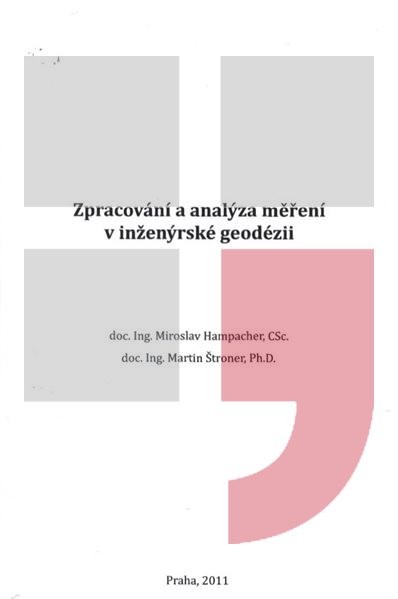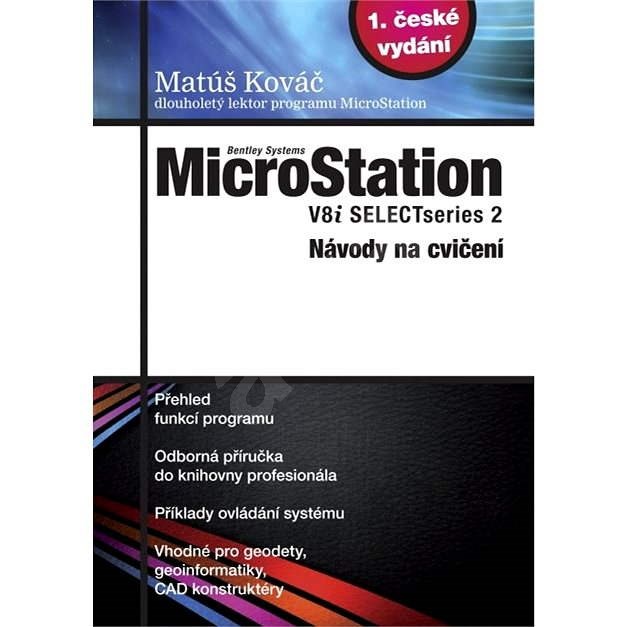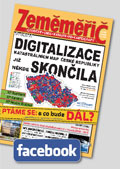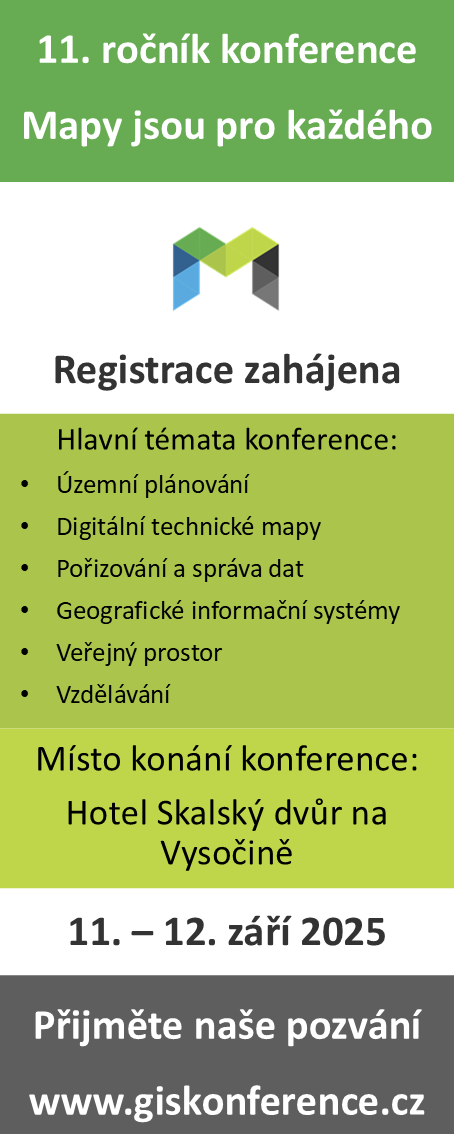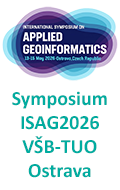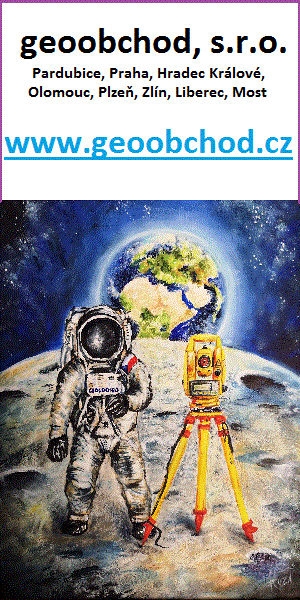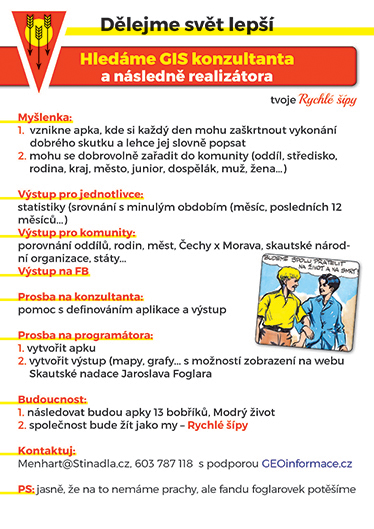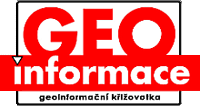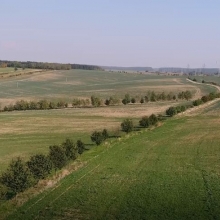zprávy
zdroje zpráv:Pozemkové úpravy, zelená krajina a trvalo udržateľný život na vidieku
22.6.2020 19:57 Komora pozemkových úprav SRKPÚ SR organizuje pracovný seminár pod záštitou ministra pôdohospodárstva
Pozemkové úpravy, zelená krajina a trvalo udržateľný život na vidieku
22.6.2020 19:57 Komora pozemkových úprav SRKPÚ SR organizuje pracovný seminár za účasti ministra pôdohospodárstva
Maxar Selected to Deliver Multi-Domain Analytics System for U.S. Department of Homeland Security
22.6.2020 15:15 GISCafe.com Webcasts-Webinars WESTMINSTER, Colo. — (BUSINESS WIRE) — June 22, 2020 —Maxar Technologies (NYSE:MAXR) (TSX:MAXR), a trusted partner and innovator …
LeoStella Delivers First BlackSky Satellites from its New Production Line
22.6.2020 15:15 GISCafe.com Webcasts-Webinars Rapid low-cost manufacturing of high-quality satellites is a realityTUKWILA, Wash. — (BUSINESS WIRE) — June 22, 2020 —
LeoStella, …
Microdrones Enters the Third Dimension with New Mapping and LiDAR Surveying Equipment
22.6.2020 15:15 GISCafe.com Webcasts-Webinars Rome, NY, June 22, 2020 (GLOBE NEWSWIRE) -- Microdrones has enjoyed a strong spring “growing season” with the launch of the popular Microdrones …20200623 – volné místo - Vrchní/odborný referent v OOO II. v TO KÚ pro Ústecký kraj
22.6.2020 14:18 ČÚZK /Urady/Katastralni-urady/Katastralni-urady/Katastralni-urad-pro-Ustecky-kraj/O-uradu/Aktuality/20200623-–-volne-misto-Vrchni-odborny-referent-v20200623 – volné místo - Vrchní/odborný referent v OOO II. v TO KÚ pro Ústecký kraj
22.6.2020 14:18 ČÚZK - předpisy a opatření Katastrální úřad pro Ústecký kraj zveřejnil novou aktualitu: Nabídka volného pracovního místa - Vrchní / odborný referent v oddělení obnovy katastrálního operátu II. v technickém odboru na Katastrálním úřadu pro Ústecký krajDavid Rumsey Map Center: Inside One of the World's Biggest Map Collections [Knihovna geografie, byTopic]
22.6.2020 12:40 Katedra aplikované geoinformatiky a kartografie Přf UK Zajímavé video z Rumsey Map CenterVýstava Poklady Mapové sbírky v Horním Slavkově [Knihovna geografie, byTopic]
22.6.2020 10:50 Katedra aplikované geoinformatiky a kartografie Přf UK Výstava Poklady Mapové sbírky je nyní k vidění v Muzeu v Horním Slavkově (Pluhova č. 211) denně v čase 9.00 – 12.00 a 12.30 – 17.00 až do 25. 8. 2020.Červnový mapathon v Praze (pozvánka)
22.6.2020 8:57 GISportal.cz
30. června se bude v Praze (Vlkova 36, Praha 3) po dlouhé době konat mapathon – nebude virtuální, ale opravdový, takže se můžete těšit na setkání a pokec. Akce se koná od 18:00 do 20:30. Na mapathonu budeme společně podle satelitních snímků v OpenStreetMap digitalizovat budovy pro map pro týmy Lékařů bez hranic v terénu. […]
The post Červnový mapathon v Praze (pozvánka) appeared first on GISportal.cz.
Další termíny školení
22.6.2020 2:00 VARS.czZáklady práce v GIS se zaměřením na ArcGIS for Desktop 8.–10. 9. 2020
Rozšíření kvalifikace pro práci v GIS se zaměřením na ArcGIS for Desktop 22.–23. 9. 2020
Další termíny školení
22.6.2020 2:00 VARS.czZáklady práce v GIS se zaměřením na ArcGIS for Desktop 8.–10. 9. 2020
Rozšíření kvalifikace pro práci v GIS se zaměřením na ArcGIS for Desktop 22.–23. 9. 2020
Omezení provozu Pobočky Mladá Boleslav
22.6.2020 0:00 Státní pozemkový úřad Z důvodu trvání havárie vodovodního řadu a s ní spojené přerušení dodávky pitné vody do budovy Ministerstva zemědělství v Mladé Boleslavi, kde sídlí i naše Pobočka Mladá Boleslav, je od 22. 6. 2020 provoz této pobočky přerušen, a to do odvolání. Děkujeme za pochopení.Harmonogram státních závěrečných zkoušek - bakalářské studium (červen 2020)
22.6.2020 0:00 Geografický ústav MUHarmonogram SZZ pro bakalářské studium (červen 2020) je ke stažení ZDE.
Harmonogram státních závěrečných zkoušek - bakalářské studium
22.6.2020 0:00 Geografický ústav MUByl zvěřejněn harmonogram státních závěrečných zkoušek Bc. studia.
Harmonogram státních závěrečných zkoušek - bakalářské studium
22.6.2020 0:00 Geografický ústav MUByl zvěřejněn harmonogram státních závěrečných zkoušek Bc. studia.
Omezení provozu Pobočky Mladá Boleslav
22.6.2020 0:00 Státní pozemkový úřad Z důvodu trvání havárie vodovodního řadu a s ní spojené přerušení dodávky pitné vody do budovy Ministerstva zemědělství v Mladé Boleslavi, kde sídlí i naše Pobočka Mladá Boleslav, je od 22. 6. 2020 provoz této pobočky přerušen, a to do odvolání. Děkujeme za pochopení.Symboly FRANKE pro TurboCAD/DAEX
20.6.2020 11:33 ŠPINAR - softwareZdarma knihovna symbolů FRANKE ke stažení pro program TurboCAD v26 a DAEX Generator v20. Knihovna obsahuje 3D modely dřezů, baterií, digestoří, odpadkových košů a dávkovačů jaru včetně textur. Symboly nejsou určeny pro funkci „Skládání dle vektoru“. Ukázka vybraných prvků z knihovny FRANKE: SYMBOLY FRANKE ke stažení zde
The post Symboly FRANKE pro TurboCAD/DAEX appeared first on ŠPINAR – software.
Symboly FRANKE pro TurboCAD/DAEX
20.6.2020 11:33 ŠPINAR - software Zdarma knihovna symbolů FRANKE ke stažení pro program TurboCAD v26 a DAEX Generator v20. Knihovna obsahuje 3D modely dřezů, baterií, digestoří, odpadkových košů a dávkovačů jaru včetně textur. Symboly nejsou určeny pro funkci „Skládání dle vektoru“. Ukázka vybraných prvků z knihovny FRANKE: SYMBOLY FRANKE ke stažení zdeURISA's Vanguard Cabinet Announces the 2020 University Student and Young Professional Digital Competition
19.6.2020 20:29 GISCafe.com Webcasts-Webinars Des Plaines, IL (June 19, 2020) URISA's Vanguard Cabinet is pleased to announce the details for the 2020 University Student and Young …Compliance testing is now available for implementations of the ‘OGC GML in JPEG 2000 (GMLJP2) Part 1: Core’ encoding standard
19.6.2020 20:28 GISCafe.com Webcasts-Webinars Products that implement the GMLJP2 standard can now be tested and certified as OGC Compliant.19 June 2020: The Open Geospatial Consortium (OGC) …
Esri users gain access to international public transport data from TravelTime
19.6.2020 19:52 GISCafe.com Webcasts-Webinars Knight Frank among early users of newly available data18 June 2020 – Esri UK today announced that partner TravelTime (previously iGeolise) …
Innovative project reaches new depths despite global pandemic
19.6.2020 19:52 GISCafe.com Webcasts-Webinars A North East water company has continued to innovate and progress a ground-breaking safety project, despite being in the middle of a global …National Underground Asset Register (NUAR) Project nominated for Digital Collaboration Award
19.6.2020 19:52 GISCafe.com Webcasts-Webinars Project now moving into Phase 2Cambridge, UK, 18th June 2020, (www.1spatial.com) 1Spatial, the global geospatial software, solutions and business …
Pantomime's Reality Faucet with Liquid LiDAR for 2020 iPad Pros Brings Realistic Physics to Augmented Reality
19.6.2020 16:33 GISCafe.com Webcasts-Webinars Pantomime Corporation has today launched the Reality Faucet augmented reality app which, on Apple's iPad Pro 2020 models, uses new LiDAR depth …PlanetObserver Announces Release of Updated Global Imagery Basemap
19.6.2020 16:33 GISCafe.com Webcasts-Webinars PlanetObserver provides geospatial data for several professionals applications such as military or civil solutions.We are proud to announce the …
Rajant and Velodyne Lidar Support Portwide Autonomy for DGWorld's ITVs at DP World’s Largest Port
19.6.2020 16:33 GISCafe.com Webcasts-Webinars M2M Wireless and Lidar Integral to Jebel Ali Port Automation by DGWorldSAN JOSE, Calif. — (BUSINESS WIRE) — June 19, 2020 …
Microdrones Invites You to Play the Ultimate Surveying Game Show: SURVEYOR SAYS.
19.6.2020 16:33 GISCafe.com Webcasts-Webinars Rome, NY, June 19, 2020 (GLOBE NEWSWIRE) -- Microdrones is hosting the ultimate Surveying Game Show, SURVEYOR SAYS, intended to test contestants on …Woolpert, Centric Consulting Helping Local Governments Access and Maximize CARES Act Funding
19.6.2020 16:33 GISCafe.com Webcasts-Webinars The partnership provides data, management and organizational support to help municipalities apply for and receive financial relief in the wake of …20200619-VŘ Správce RÚIAN
19.6.2020 15:08 ČÚZK - předpisy a opatření Český úřad zeměměřický a katastrální zveřejnil novou aktualitu: Oznámení o vyhlášení výběrového řízení na obsazení služebního místa odborný rada - Správce RÚIAN.Správce RÚIAN
19.6.2020 14:59 ČÚZK - předpisy a opatření Český úřad zeměměřický a katastrálnívypisuje výběrové řízení na místo
Správce RÚIAN
Správce RÚIAN
19.6.2020 14:59 ČÚZK - volná místa Český úřad zeměměřický a katastrální vypisuje výběrové řízení na místo Správce RÚIANSprávce RÚIAN
19.6.2020 14:59 ČÚZK /Urady/Cesky-urad-zememericky-a-katastralni/Uredni-deska/Oznameni-a-jina-uredni-sdeleni/Volna-mista/DMS/Spravce-RUIANvrchní referent / rada v oddělení podpory ICT v technickém odboru
19.6.2020 13:29 ČÚZK - předpisy a opatření Katastrální úřad pro Liberecký krajvypisuje výběrové řízení na místo
vrchní referent / rada v oddělení podpory ICT v technickém odboru
vrchní referent / rada v oddělení podpory ICT v technickém odboru
19.6.2020 13:29 ČÚZK - volná místa Katastrální úřad pro Liberecký kraj vypisuje výběrové řízení na místo vrchní referent / rada v oddělení podpory ICT v technickém odboruvrchní referent / rada v oddělení podpory ICT v technickém odboru
19.6.2020 13:29 ČÚZK /Urady/Katastralni-urady/Katastralni-urady/Katastralni-urad-pro-Liberecky-kraj/Uredni-deska/Oznameni-a-jina-uredni-sdeleni/Volna-mista/vrchni-referent-rada-v-oddeleni-podpory-ICT-v-tPřipravili jsme verze 14.73 našich produktů
19.6.2020 12:46 GEPROPublikovali jsme verze 14.73 našich produktů MISYS, MISYS-WEB – licenční server, KOKEŠ, Geoportál GEPRO i PROLAND.… >>
Krátkodobé přerušení provozu DP a WSDP v pátek 19.6. od 20:00 do cca 20:30.
19.6.2020 12:27 ČÚZK /Aplikace-DP-do-KN/Aplikace-DP-do-KN/Archiv-DP/292598Krátkodobé přerušení provozu DP a WSDP v pátek 19.6. od 20:00 do cca 20:30.
19.6.2020 12:27 ČÚZK - předpisy a opatření Vážení uživatelé,Z provozních důvodů dojde v pátek 19.6. od 20:00 do cca 20:30 ke krátkodobému přerušení provozu Dálkového přístupu i Webových služeb dálkového přístupu.
Za komplikace tímto způsobené se omlouváme a děkujeme za pochopení.
Krátkodobé přerušení provozu DP a WSDP v pátek 19.6. od 20:00 do cca 20:30.
19.6.2020 12:27 Dálkový přístup k údajům KN ČR Vážení uživatelé,Z provozních důvodů dojde v pátek 19.6. od 20:00 do cca 20:30 ke krátkodobému přerušení provozu Dálkového přístupu i Webových služeb dálkového přístupu.
Za komplikace tímto způsobené se omlouváme a děkujeme za pochopení.
Rada/odborný rada v oddělení aktualizace GI KN na Katastrálním pracovišti Brno - město
19.6.2020 11:54 ČÚZK /Urady/Katastralni-urady/Katastralni-urady/Katastralni-urad-pro-Jihomoravsky-kraj/Uredni-deska/Oznameni-a-jina-uredni-sdeleni/Volna-mista/DMS/Rada-odborny-rada-v-oddeleni-aktualizace-GI-KN-naRada/odborný rada v oddělení aktualizace GI KN na Katastrálním pracovišti Brno - město
19.6.2020 11:54 ČÚZK - předpisy a opatření Katastrální úřad pro Jihomoravský kraj Katastrální pracoviště Brno-městovypisuje výběrové řízení na místo
Rada/odborný rada v oddělení aktualizace GI KN na Katastrálním pracovišti Brno - město
Rada/odborný rada v oddělení aktualizace GI KN na Katastrálním pracovišti Brno - město
19.6.2020 11:54 ČÚZK - volná místa Katastrální úřad pro Jihomoravský kraj Katastrální pracoviště Brno-město vypisuje výběrové řízení na místo Rada/odborný rada v oddělení aktualizace GI KN na Katastrálním pracovišti Brno - město【SatLab Webinar】 New Features Overview in Satsurv 2.0.3 to 2.0.4
19.6.2020 11:45 Satlab GeosolutionsSatLab Webinar-30th June, 2020 What to expect in this Webinar: 1. Tips for Project Management 2. New Features in Surveying and Staking out Interface 3. Introduction of Different Tilt Survey Modes of SatLab Receivers Presenter: Lukasz Migda Country manager of SatLab Geosolutions in Poland
The post 【SatLab Webinar】 New Features Overview in Satsurv 2.0.3 to 2.0.4 appeared first on Satlab – Global Satellite Positioning Solutions.
【SatLab Webinar】 New Features Overview in Satsurv 2.0.3 to 2.0.4
19.6.2020 11:45 Satlab GeosolutionsSatLab Webinar-30th June, 2020 What to expect in this Webinar: 1. Tips for Project Management 2. New Features in Surveying and Staking out Interface 3. Introduction of Different Tilt Survey Modes of SatLab Receivers Presenter: Lukasz Migda Country manager of SatLab Geosolutions in Poland
The post 【SatLab Webinar】 New Features Overview in Satsurv 2.0.3 to 2.0.4 appeared first on Satlab – Global Satellite Positioning Solutions.
【SatLab Webinar】 New Features Overview in Satsurv 2.0.3 to 2.0.4
19.6.2020 11:45 Satlab GeosolutionsSatLab Webinar-30th June, 2020 What to expect in this Webinar: 1. Tips for Project Management 2. New Features in Surveying and Staking out Interface 3. Introduction of Different Tilt Survey Modes of SatLab Receivers Presenter: Lukasz Migda Country manager of SatLab Geosolutions in Poland
The post 【SatLab Webinar】 New Features Overview in Satsurv 2.0.3 to 2.0.4 appeared first on Satlab – Global Satellite Positioning Solutions.
【SatLab Webinar】 New features overview in Satsurv 2.0.3 to 2.0.4
19.6.2020 11:45 Satlab GeosolutionsSatLab Webinar-30th June, 2020 What to expect in this Webinar: 1. Tips for Project Management 2. New Features in Surveying and Staking out Interface 3. Introduction of Different Tilt Survey Modes of SatLab Receivers Presenter: Lukasz Migda Country manager of SatLab Geosolutions in Poland
The post 【SatLab Webinar】 New features overview in Satsurv 2.0.3 to 2.0.4 appeared first on Satlab – Global Satellite Positioning Solutions.
Oddělení hospodářské správy - pracovní poměr - domovník
19.6.2020 11:22 ČÚZK - volná místa Katastrální úřad pro Jihočeský kraj kancelář ředitele vypisuje výběrové řízení na místo Oddělení hospodářské správy - pracovní poměr - domovníkOddělení hospodářské správy - pracovní poměr - domovník
19.6.2020 11:22 ČÚZK - předpisy a opatření Katastrální úřad pro Jihočeský kraj kancelář ředitelevypisuje výběrové řízení na místo
Oddělení hospodářské správy - pracovní poměr - domovník
Oddělení hospodářské správy - pracovní poměr - domovník
19.6.2020 11:22 ČÚZK /Urady/Katastralni-urady/Katastralni-urady/Katastralni-urad-pro-Jihocesky-kraj/Volna-mista/DMS/Oddeleni-hospodarske-spravy-pracovni-pomer-domEarth from Space: Great Rift Valley, Kenya
19.6.2020 10:00 ESA Observing the Earth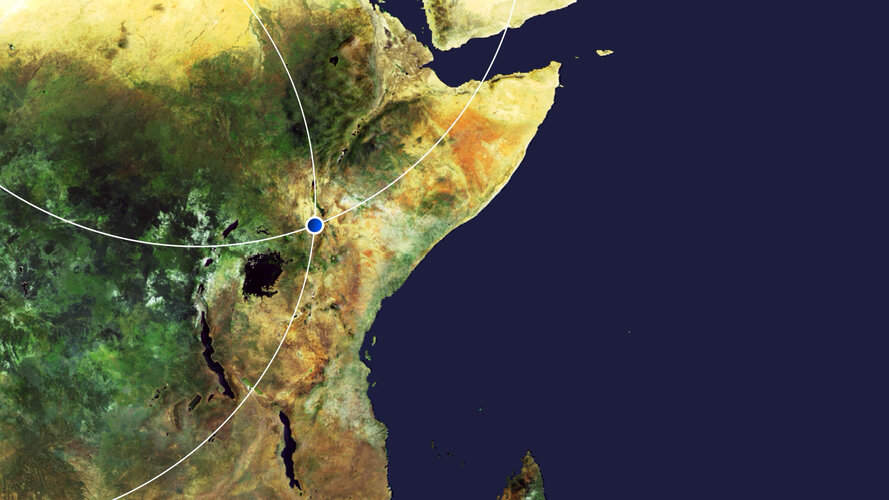 Video:
00:00:00
Video:
00:00:00
In this week's edition of the Earth from Space programme, the Copernicus Sentinel-2 mission takes us over part of the Great Rift Valley, Kenya.
See also Great Rift Valley, Kenya to download the image.
Great Rift Valley, Kenya
19.6.2020 10:00 ESA Observing the Earth Image:
The Copernicus Sentinel-2 mission takes us over part of the Great Rift Valley, Kenya.
Image:
The Copernicus Sentinel-2 mission takes us over part of the Great Rift Valley, Kenya.
Earth from Space: Great Rift Valley, Kenya
19.6.2020 10:00 ESA Observing the Earth Video:
00:00:00
Video:
00:00:00
In this week's edition of the Earth from Space programme, the Copernicus Sentinel-2 mission takes us over part of the Great Rift Valley, Kenya.
See also Great Rift Valley, Kenya to download the image.
Great Rift Valley, Kenya
19.6.2020 10:00 ESA Observing the Earth Image:
The Copernicus Sentinel-2 mission takes us over part of the Great Rift Valley, Kenya.
Image:
The Copernicus Sentinel-2 mission takes us over part of the Great Rift Valley, Kenya.
Travis Bodin, PLS, PMP Named Vice President of Fenstermaker's Survey & Mapping Division
19.6.2020 9:00 GISCafe.com Webcasts-Webinars Lafayette, LA, June 18, 2020 (GLOBE NEWSWIRE) -- C. H. Fenstermaker & Associates, L.L.C. has announced the promotion of Travis Bodin, PLS, PMP …Katastrální mapa ve formátech DGN a DXF poskytovaná v e-shopu
19.6.2020 2:00 Cenia - Katalog metadat ČR - INSPIRE Katastrální mapa je závazným státním mapovým dílem velkého měřítka, obsahuje body polohového bodového pole, polohopis a popis. Katastrální mapa ve vektorové podobě je poskytována zdarma ve formátu DGN a DXF a obsahuje prvky Digitální katastrální mapy (DKM) a Katastrální mapy digitalizované (KMD), tedy bodová pole, budovy, další prvky mapy, hranice parcel, katastrální hranice, parcely katastru nemovitostí, prvky orientační mapy a hranice věcného břemene. Z důvodu použití formátu DGN produkt neobsahuje značky na liniích a oblouky jsou nahrazeny lomenými čárami. Katastrální mapa ve vektorové podobě k 15. 06. 2020 pokrývá 96,81% území České republiky, t.j. 76 347,80km2. Více katastrální vyhláška č.357/2013 Sb. v platném znění.INSPIRE téma Budovy (BU)
19.6.2020 2:00 Cenia - Katalog metadat ČR - INSPIRE Data odpovídají směrnici INSPIRE pro téma budovy (BU). Data pochází částečně z projektu RÚIAN (Registr územní identifikace, adres a nemovitostí), který je součástí základních registrů České Republiky a obsahuje informace o územní identifikaci, adresách a nemovitostech, a částečně z ISKN (Informační systém katastru nemovistostí). Zdrojem informací o budovách v ISKN je objekt Stavba, v RÚIAN je to Stavební objekt. Většina Staveb je zároveň Stavebními objekty, ale jsou případy, kdy tomu tak není. Kromě Budov datová sada obsahuje i části budov, které jsou pro potřeby INSPIRE vyjádřeny vchody z RÚIAN. Vchody obsahují informace o počtu podlaží, technickoekonomických atributech apod. Datová sada pokrývá celé území české republiky. V datové sadě není uvedeno 1,14%, t.j. 48344 budov (k 15. 06. 2020), protože neobsahují definiční bod ani polygon. Více v zákoně č. 111/2009 Sb., o základních registrech, ve vyhlášce č. 359/2011 Sb., o základním registru územní identifikace, adres a nemovitostí v platných zněních, v zákoně 256/2013 Sb., o katastru nemovitostí, v katastrální vyhlášce č. 357/2013 Sb. v platném znění a INSPIRE Data Specification on Buildings v 3.0 z 13.12.2013. Data ve formátu GML 3.2.1 jsou validní proti schématu XML pro INSPIRE téma Budovy ve verzi 4.0 a proti schématu pro prostorová data ELF ve verzi 1.0.INSPIRE téma Adresy (AD)
19.6.2020 2:00 Cenia - Katalog metadat ČR - INSPIRE Data odpovídají směrnici INSPIRE pro téma adresy (AD). Vychází především z projektu RÚIAN (Registr územní identifikace, adres a nemovitostí), který je součástí základních registrů České Republiky a obsahuje informace o územní identifikaci, adresách a nemovitostech. Data publikovaná v rámci INSPIRE obsahují pouze adresní místa a jejich komponenty, kterými jsou stát, obec, část obce, městský obvod v Praze (MOP), městký obvod/městská část (MO/MČ), ulice a pošta a to na území celé České Republiky. Obsahují rozvněž geometrii, která určuje definiční bod adresního místa. V datové sadě nění uvedeno 1,14%, t.j. 33528 adresních míst (k 15. 06. 2020), protože neobsahují definiční bod, podle kterého by je bylo možné prostorově určit. Více v zákoně č. 111/2009 Sb., o základních registrech a ve vyhlášce č. 359/2011 Sb., o základním registru územní identifikace, adres a nemovitostí v platných zněních a INSPIRE Data Specification on Addresses v 3.0.1 z 26.4.2010. Data ve formátu GML 3.2.1 jsou validní proti schématu XML pro INSPIRE téma Adresy ve verzi 4.0 a proti schématu pro prostorová data ELF ve verzi 1.0.INSPIRE téma Rozšířené Parcely (CPX)
19.6.2020 2:00 Cenia - Katalog metadat ČR - INSPIRE Rozšíření má za cíl poskytovat katastrální mapu s obsahem podle vyhlášky ve vektorové podobě ve struktuře plně v souladu se strukturou danou směrnicí INSPIRE. Data rozšiřují směrnici INSPIRE pro téma katastrální parcely (CP) o věcná břemena, geodetické body, další prvky mapy, původní obloukovou geometrii a o parcely určené definičním bodem (ty pouze v oblastech s analogovou mapou). Vychází z katastrální mapy, která je závazným státním mapovým dílem velkého měřítka, obsahuje body polohového bodového pole, polohopis a popis a může mít formu digitální mapy, analogové mapy nebo digitalizované mapy. Publikovaná data obsahují katastrální území pro celou Českou Republiku, parcely a jejich hranice, věcná břemena, další prvky mapy a původní obloukovou geometrii z území, kde je digitální mapa (k 15. 06. 2020 je to 96,81% území České republiky, t.j. 76 347,80km2) a ve zbytku území katastrální parcely určené pouze definičním bodem (tedy bez hranic a polygonu). Katastrální parcely a hranice obsahují oproti datové sadě INSPIRE některé atributy navíc. Jedná se o typ hranice, způsob využití území, druh pozemku, vazbu na budovu a o mapové značky. Více katastrální zákon 344/1992 SB., katastrální vyhláška č.26/2007 Sb. v platném znění a INSPIRE Data Specification on Cadastral Parcels v 3.0.1. Data ve formátu GML 3.2.1 jsou validní proti schématu XML pro Rozšířené Parcely (CPX) ve verzi 4.0.INSPIRE téma Parcely (CP)
19.6.2020 2:00 Cenia - Katalog metadat ČR - INSPIRE Data odpovídají směrnici INSPIRE pro téma katastrální parcely (CP). Vychází z katastrální mapy, která je závazným státním mapovým dílem velkého měřítka, obsahuje body polohového bodového pole, polohopis a popis a může mít formu digitální mapy, analogové mapy nebo digitalizované mapy. Data publikovaná v rámci INSPIRE obsahují pouze katastrální území (pro celou Českou Republiku) a parcely a jejich hranice z území, kde je digitální mapa (k 15. 06. 2020 je to 96,81% území České republiky, t.j. 76 347,80km2). Více katastrální zákon 344/1992 SB., katastrální vyhláška č.26/2007 Sb. v platném znění a INSPIRE Data Specification on Cadastral Parcels v 3.0.1. Data ve formátu GML 3.2.1 jsou validní proti schématu XML pro INSPIRE téma Parcely ve verzi 4.0 a proti schématu pro prostorová data ELF ve verzi 1.0.Saudi Arabia Launches COVID-19 Dashboard Using Esri Technology
19.6.2020 0:52 GISCafe.com Webcasts-Webinars The Country's Ministry of Health Is Tracking Pandemic Cases with New GIS ResourcesREDLANDS, Calif. — (BUSINESS WIRE) — June 18, 2020 …
Před pouhým půl rokem dokončené poldry ochránily Kobeřice před 30letou vodou
19.6.2020 0:00 Státní pozemkový úřad Praha, 19. 6. 2020: Realizaci 1. etapy prioritních společných zařízení vybraných obcí Kobeřice ze schváleného návrhu pozemkových úprav dokončila Pobočka Opava na sklonku loňského roku. Dva vybudované poldry získaly kolaudační rozhodnutí 11. prosince 2019. Aktuální počasí již dokonce prověřilo jejich účinnost a smysluplnost. Podle zástupců obce napadlo 18. 6. 2020 v jejich katastru 49 mm srážek za cca 1 h. Obec na svém facebookovém profilu uvedla, že: „Díky poldrům, které transformovaly cca 30letou vodu, nedošlo k vylití Oldřišovského potoka a větším škodám na majetku."Omezení provozu Pobočky Mladá Boleslav
19.6.2020 0:00 Státní pozemkový úřad Z důvodu havárie na rozvodech vody nebo odpadů v budově Ministerstva zemědělství v Mladé Boleslavi, kde sídlí i naše Pobočka Mladá Boleslav, bude dnes 19. 6. 2020 chod této pobočky omezen. Základní chod pracoviště zajišťuje do 14 hodin vedoucí pobočky, zachován je i chod podatelny. Děkujeme za pochopení.Omezení provozu Pobočky Mladá Boleslav
19.6.2020 0:00 Státní pozemkový úřad Z důvodu havárie na rozvodech vody nebo odpadů v budově Ministerstva zemědělství v Mladé Boleslavi, kde sídlí i naše Pobočka Mladá Boleslav, bude dnes 19. 6. 2020 chod této pobočky omezen. Základní chod pracoviště zajišťuje do 14 hodin vedoucí pobočky, zachován je i chod podatelny. Děkujeme za pochopení.Real-Time, Accurate Corrections for Today’s GIS & Mapping Professionals - Interview with Towfique Ahmed, Product Engineer, Trimble
18.6.2020 21:31 GISCafe.com Webcasts-WebinarsFortem Technologies Brings First-Of-Its-Kind Complete End-to-End Counter Drone Security to Gulf Region
18.6.2020 18:41 GISCafe.com Webcasts-Webinars Pleasant Grove, UT, June 18, 2020 (GLOBE NEWSWIRE) -- Fortem Technologies, the technical leader for counter drone security and defense solutions, …AeroDefense Partners with US Air Force to Develop Ruggedized and Rapid Deploy Drone Detection
18.6.2020 18:41 GISCafe.com Webcasts-Webinars AeroDefense Technology to Detect, Locate, Track Drones and Their Pilots to Protect Mobile Defenders Against Drone-Borne Attacks and Unauthorized …Property Agent Makes $50k in 2 Weeks by Tapping on New Portal’s Geospatial Data and AI Technology
18.6.2020 16:00 GISCafe.com Webcasts-Webinars Singapore, June 17, 2020 (GLOBE NEWSWIRE) -- Marcus Ong of Century 21 Property Agency, joined the Property Concierge (PC) at MOGUL.sg last February …Lytx Launches Solutions for Fleet Tracking, Enabling Real-time, Location-based Video Search
18.6.2020 16:00 GISCafe.com Webcasts-Webinars SAN DIEGO, June 18, 2020 — (PRNewswire) — Lytx®, a leading global provider of machine vision and artificial …Cambridge Semantics Introduces Geospatial Analytics within its Award-Winning AnzoGraph® DB
18.6.2020 16:00 GISCafe.com Webcasts-Webinars AnzoGraph® DB Now Combines Scalable Location Analytics with Relationships and Graph AnalyticsBOSTON, June 18, 2020 — (PRNewswire) — …
Delphi Technologies and TomTom ADAS Map innovation delivers fuel savings of more than 10 percent in passenger cars
18.6.2020 16:00 GISCafe.com Webcasts-Webinars - Combined software package can deliver significant, real-world returns with little-or-no impact on drive times, preferred routes or driving …Změna adresy
18.6.2020 14:56 ČÚZK - předpisy a opatření Katastrální úřad pro Plzeňský kraj - Katastrální pracoviště Kralovice zveřejnil novou aktualitu: Dne 18.6.2020 se KP Kralovice přesunulo na adresu Osvobození 886, Kralovice.Změna adresy
18.6.2020 14:56 ČÚZK /Urady/Katastralni-urady/Katastralni-urady/Katastralni-urad-pro-Plzensky-kraj/O-uradu/Aktuality/Zmena-adresyZměna adresy
18.6.2020 14:56 ČÚZK - předpisy a opatření Katastrální úřad pro Plzeňský kraj - Katastrální pracoviště Kralovice zveřejnil novou aktualitu: Dne 18.6.2020 se KP Kralovice přesunulo na adresu nám. Osvobození 886, Kralovice.Změna adresy
18.6.2020 14:51 ČÚZK /Urady/Katastralni-urady/Katastralni-urady/Katastralni-urad-pro-Plzensky-kraj/Katastralni-pracoviste/KP-Kralovice/O-uradu/Aktuality/Zmena-adresyZměna adresy
18.6.2020 14:51 ČÚZK - předpisy a opatření Katastrální úřad pro Plzeňský kraj zveřejnil novou aktualitu: Dne 18.6.2020 se KP Kralovice přesunulo na adresu nám. Osvobození 886, Kralovice.Změna adresy
18.6.2020 14:51 ČÚZK - předpisy a opatření Katastrální úřad pro Plzeňský kraj zveřejnil novou aktualitu: Dne 18.6.2020 se KP Kralovice přesunulo na adresu Osvobození 886, Kralovice.Call for Media: ESA, NASA and JAXA to unveil COVID-19 Earth Observation Dashboard
18.6.2020 14:50 ESA Observing the EarthPress Release N° 10–2020
ESA, NASA and JAXA invite the general public and media representatives to participate in an online media conference on Thursday, 25 June, at 09:00 EDT (15:00 CEST) where they will present a new dashboard that uses Earth observation data to show the impacts of COVID-19. This new platform will combine data, technical knowledge and expertise of the three space agencies to strengthen our global understanding of the environmental and economic impacts of the COVID-19 pandemic.
Call for Media: ESA, NASA and JAXA to unveil COVID-19 Earth Observation Dashboard
18.6.2020 14:50 ESA Observing the EarthPress Release N° 10–2020
ESA, NASA and JAXA invite the general public and media representatives to participate in an online media conference on Thursday, 25 June, at 09:00 EDT (15:00 CEST) where they will present a new dashboard that uses Earth observation data to show the impacts of COVID-19. This new platform will combine data, technical knowledge and expertise of the three space agencies to strengthen our global understanding of the environmental and economic impacts of the COVID-19 pandemic.
Listiny do Sbírky listin
18.6.2020 11:04 ČÚZK - předpisy a opatření Katastrální úřad pro Jihočeský kraj - Katastrální pracoviště Strakonicezveřejnil novou aktualitu: Listiny, které ukládáme do Sbírky listin, nám prosím zasílejte pouze ve formátu PDF/A.
Listiny do Sbírky listin
18.6.2020 11:04 ČÚZK /Urady/Katastralni-urady/Katastralni-urady/Katastralni-urad-pro-Jihocesky-kraj/Katastralni-pracoviste/KP-Strakonice/O-uradu/Aktuality/Listiny-do-Sbirky-listinListiny do Sbírky listin
18.6.2020 11:04 ČÚZK - předpisy a opatření Český úřad zeměměřický a katastrální - Katastrální pracoviště Strakonicezveřejnil novou aktualitu: Listiny, které ukládáme do Sbírky listin, nám prosím zasílejte pouze ve formátu PDF/A.
GNSS raw measurements take centre stage at GSA workshop
18.6.2020 10:12 European GNSS Agency
Over 200 participants from 32 countries took part in the fourth GNSS Raw Measurements Task Force Workshop, held online on 27-28 May 2020. At the workshop, participants had the opportunity to learn about progress around the use of raw measurements in Android devices and to benefit from the experience of the GSA’s Raw Measurements Task Force.
By sharing knowledge and experience around raw measurement use, the GNSS Raw Measurements Task Force Workshops increase the global understanding of raw measurements and advance the science and practice of implementing raw measurements in apps and devices. This year the event was online, with lively discussions held over the two days of the workshop.
Sharing knowledge
In his keynote presentation on May 27, Google`s Frank Van Diggelen spoke about updated Google tools for logging and analysing GNSS measurements, with new features already available in GnssLogger, such as logging in RINEX format or logging of other sensor data, or in GNSS Analysis software - such as new PVT filters or “select satellite for position”. Additional features (e.g. antenna phase centre offset), to be available with the Android 11 release in the third quarter of this year, were also highlighted.
Read this: Hackers take on Raw Galileo challenge
Discussions at the workshop confirmed that GNSS raw measurements are increasingly used in educational and scientific projects around the world, leading to increased knowledge and interest in GNSS technology and better implementation of GNSS within smartphones. In addition, there is already a growing body of evidence that sub-meter positioning is feasible in real-time with current smartphones when using RTK and other techniques. So, it is just a question of when, rather than if, it will become widely used. What’s more, test results from dual frequency chipsets presented at the workshop showed Galileo’s added-value in improving accuracy by reducing multipath.
“The Raw Measurements Task Force Workshop allows all stakeholders interested in raw measurement use to share their knowledge and experience and to ensure that the benefits of GNSS raw measurements are enjoyed by as many people as possible,” the GSA’s Head of Market Development Fiammetta Diani said in her welcome address.
And this: Power-efficient positioning for the IoT
Over 20 interesting presentations
The day concluded with presentations from Airbus (Tomasz Lewandowski) and ESA (Xurxo Otero) showing test results with dual-frequency smartphones and evaluation kits. There were also presentations from Qascom (Carlo Sarto) on future OS-NMA use in smartphones; the GSA (Joaquin Reyes) on how raw measurements improve the digitalisation of CAP controls; EC (Katarzyna Porzuc) on GNSS raw measurements in the context of ensuring caller location in emergency communications; and JRC (Maria Angeles Aragon) about the NeQuick-G algorithm.
On the second day of the workshop, when another eleven contributions were presented, Rokubun CTO Miquel Garcia-Fernandez spoke about WiFi RTT (Round Trip Time) measurements as the GNSS companion for Indoor Positioning. Regarding the workshop, he said: “After four editions, the GSA Raw Measurements Task Force has matured and has become a reference to be up to date in recent advances regarding GNSS data processing for mobile devices.”
“Its participants, from public institutions, academia, big companies as well as SMEs provide an updated and relevant snapshot of the GNSS community developing new location technology for smartphones,” Garcia-Fernandez said.
For an overview of all the presentations made at the workshop, click here.
Join the Task Force
The GNSS Raw Measurements Task Force is dedicated to promoting a better and wider use of GNSS raw measurements.
Since its launch in 2017, the Task Force has expanded from a handful of experts to a community of over 100 agencies, universities, research institutes and companies. Membership is open to anybody interested in GNSS raw measurements. To join the Task Force contact: market@gsa.europa.eu.
Media note: This feature can be republished without charge provided the European GNSS Agency (GSA) is acknowledged as the source at the top or the bottom of the story. You must request permission before you use any of the photographs on the site. If you republish, we would be grateful if you could link back to the GSA website (http://www.gsa.europa.eu).
Pozvánka na výstavu Dědictví zmizelých krajin Česka [Knihovna geografie, byTopic]
18.6.2020 9:20 Katedra aplikované geoinformatiky a kartografie Přf UKCarlson Software Releases Precision 3D Topo 2020 and Precision 3D Hydro 2020
18.6.2020 6:01 Carlson Software Maysville, Ky., U.S.A. (June 18, 2020) – Carlson Software today announced the release of major updates to its Precision 3D Topo 2020 and Precision 3D Hydro 2020 software, enabling new, extremely efficient workflows that utilize the best of a 3D design environment while providing traditional CAD deliverables. For Departments of Transportation, county highway offices and […]geoProspector is now available. Be the first to get the ArcGIS Pro add-in that allows you to download data from REST MapServices.
18.6.2020 1:55 GISCafe.com Webcasts-Webinars Denver, CO (June 17, 2020) - geoWidgets is pleased to announce the release of its newest product, geoProspector. The geoProspector ArcGIS …iXblue, Woolpert Partner to Deliver Lidar Mapping Services to New Zealand Councils
18.6.2020 1:50 GISCafe.com Webcasts-Webinars Woolpert and iXblue Sea Operations division, part of the French-based iXblue Group, have been awarded two significant airborne lidar mapping projects …ATLID completes the European set of EarthCARE instruments
18.6.2020 1:32 GISCafe.com Webcasts-Webinars Successful integration of ATLID completes the European set of instruments for EarthCARE satelliteAirbus-built ESA/JAXA mission will improve …
Qingyuan Pumped Storage Hydroelectric Power Plant
17.6.2020 21:54 Bentley SystemsPress Coverage
NS Energy, UK
Read the articleBentley Institute announces “Digital Infrastructure Student Idea Challenge 2020”
17.6.2020 21:52 Bentley SystemsPress Coverage
AECCafe, USA
Read the articleBentley’s COVID-19 Response—Free Bentley ProjectWise 365 Till September 30
17.6.2020 21:48 Bentley SystemsPress Coverage
Architosh, USA
Read the articleTo Support Infrastructure Engineering Ecosystems Working from Home, Bentley Systems Opens Up Full Access to ProjectWise 365 and Waives Subscription Fees through September 30
17.6.2020 21:44 Bentley SystemsPress Coverage
AECCafe, USA
Read the articleBentley Systems Opens Up Full Access to ProjectWise 365 To Infrastructure Engineering Ecosystems Working from Home
17.6.2020 21:35 Bentley SystemsPress Coverage
ARC Advisory Group, USA
Read the articleInterview: 4D and Future of Digital Construction
17.6.2020 21:31 Bentley SystemsPress Coverage
AEC Next, USA
Read the articleWatch Vega's rideshare launch live
17.6.2020 17:45 ESA Observing the Earth
Update: Arianespace has taken the decision to initiate the final chronology operations for flight VV16 on Monday, 29 June at 02:51 BST / 03:51 CEST (22:51 on 28 June Kourou local time). This is subject to a favourable evolution of the weather conditions.
The Vega launch vehicle and its 53 spacecraft payloads are in stable and safe conditions.
Tune in to ESA Web TV to watch the return to flight of Vega on its debut rideshare mission dedicated to light satellites.
Watch Vega's rideshare launch live
17.6.2020 17:45 ESA Observing the Earth
Updated: New launch date due to unfavourable weather at altitude above Europe's Spaceport.
Tune in to ESA Web TV on Sunday 21 June from 02:36 BST / 03:36 CEST to watch the return to flight of Vega on its debut rideshare mission dedicated to light satellites.
Vega will lift off from Europe's Spaceport in French Guiana carrying 53 satellites on its new dispenser called the Small Spacecraft Mission Service, or SSMS.
Watch Vega's rideshare launch live
17.6.2020 17:45 ESA Observing the Earth
Update: Tune in tonight to ESA Web TV to watch the return to flight of Vega on its debut rideshare mission dedicated to light satellites.
Today’s predicted meteorological conditions over Europe's Spaceport enable the consideration of resuming chronological operations for the Vega Flight VV16 launch. Subject to confirmation of favourable conditions, the new targeted liftoff is Sunday, 28 June at 02:51 BST / 03:51 CEST (22:51 on 27 June Kourou local time).
The Vega launch vehicle and its 53 spacecraft payloads are in stable and safe conditions.
Watch Vega's rideshare launch live
17.6.2020 17:45 ESA Observing the Earth
Updated: Subject to favourable weather conditions, the soonest possible launch date for the SSMS proof-of-concept flight is Sunday 21 June from 02:36 BST / 03:36 CEST (20 June at 22:51 local time in Kourou).
Please check here for updates.
Watch Vega's rideshare launch live
17.6.2020 17:45 ESA Observing the Earth
Update: As high-altitude winds above Europe's Spaceport remain unfavourable, Arianespace has taken the decision not to initiate the final chronology operations for Flight VV16 on Sunday 20 June (19 June in Kourou).
A new target date will be announced as soon as possible, based on the evolution of weather conditions.
The Vega launch vehicle and its 53 spacecraft payloads are in stable and safe conditions.
Please check here for updates.
Vega launch postponed
17.6.2020 17:45 ESA Observing the Earth
Update: Arianespace has decided to postpone Vega flight VV16 due to unfavourable weather. A new launch date is to be announced. More information will be available soon.
The Vega launch vehicle and its 53 spacecraft payloads remain stable and in total safety.
Vega launch postponed until 17 August
17.6.2020 17:45 ESA Observing the Earth
A new launch date of 17 August 2020 has been announced by Arianespace for Vega flight VV16.
Tonight! Watch Vega's rideshare launch live
17.6.2020 17:45 ESA Observing the Earth
Update: Tune in tonight to ESA Web TV to watch the return to flight of Vega on its debut rideshare mission dedicated to light satellites.
Today’s predicted meteorological conditions over Europe's Spaceport enable the consideration of resuming chronological operations for the Vega Flight VV16 launch. Subject to confirmation of favourable conditions, the new targeted liftoff is Sunday, 28 June at 02:51 BST / 03:51 CEST (22:51 on 27 June Kourou local time).
The Vega launch vehicle and its 53 spacecraft payloads are in stable and safe conditions.
Vega launch postponed
17.6.2020 17:45 ESA Observing the Earth
Update: Arianespace has decided to postpone Vega flight VV16 due to unfavourable weather. A new launch date is to be announced. More information will be available soon.
The Vega launch vehicle and its 53 spacecraft payloads remain stable and in total safety.
Watch Vega's rideshare launch live
17.6.2020 17:45 ESA Observing the Earth
Update: Arianespace has taken the decision to initiate the final chronology operations for flight VV16 on Sunday, 29 June at 02:51 BST / 03:51 CEST (22:51 on 28 June Kourou local time). This is subject to a favourable evolution of the weather conditions.
The Vega launch vehicle and its 53 spacecraft payloads are in stable and safe conditions.
Tune in to ESA Web TV to watch the return to flight of Vega on its debut rideshare mission dedicated to light satellites.
Xplore awarded mission analysis by NOAA to study Lagrange point solar observation and space weather monitoring to protect critical infrastructure on Earth
17.6.2020 16:29 GISCafe.com Webcasts-Webinars Xplore studies Xcraft™ mission for NOAA at Earth-Sun L1 Lagrange point, one million miles from EarthSEATTLE, June 17, 2020 — (PRNewswire) …
DroneBase Secures $7.5 Million to Bolster Growth in Renewable Energy and Automated Data Analysis
17.6.2020 16:29 GISCafe.com Webcasts-Webinars Following Months of Record-Setting Revenue, Company Establishes DroneBase Europe to Serve Expanding Customer BaseLOS ANGELES — (BUSINESS WIRE) …
SMOS monitoring droughts
17.6.2020 16:19 ESA Observing the Earth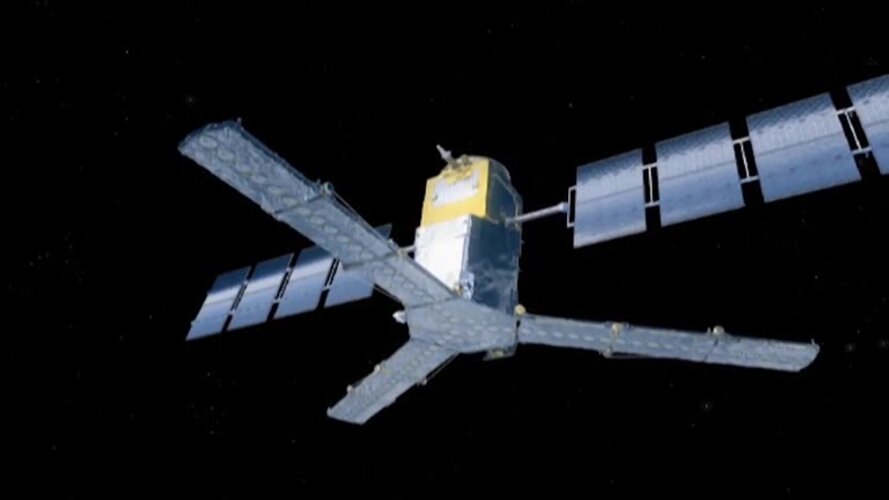 Video:
00:03:00
Video:
00:03:00
In orbit for more than a decade, ESA’s Earth Explorer satellite SMOS has not only exceeded its planned lifespan, but also surpassed its original scientific goals. Built to demonstrate new technology in space and address gaps in our scientific understanding of how Earth works as a system, this remarkable mission is now also being used for a number of practical applications. With drought seemingly more commonplace, entrepreneurs are using information on soil moisture from SMOS and data from other satellites to generate commercial data products for the insurance market, ultimately bringing benefits to farmers.
This video includes interviews of :
Klaus Scipal: SMOS Mission Manager, ESA, Soundbites in English & German
Thijs van Leeuwen: CEO of VanderSat – Soundbites in English & Dutch
Marcel Andriesse: Senior underwriter agri-culture Swiss Re - Soundbites in English & Dutch
Rada/odborný rada v právním oddělení č.1 na Katastrálním pracovišti Brno - město
17.6.2020 14:24 ČÚZK - volná místa Katastrální úřad pro Jihomoravský kraj Katastrální pracoviště Brno-město vypisuje výběrové řízení na místo Rada/odborný rada v právním oddělení č.1 na Katastrálním pracovišti Brno - městoRada/odborný rada v právním oddělení č.1 na Katastrálním pracovišti Brno - město
17.6.2020 14:24 ČÚZK - předpisy a opatření Katastrální úřad pro Jihomoravský kraj Katastrální pracoviště Brno-městovypisuje výběrové řízení na místo
Rada/odborný rada v právním oddělení č.1 na Katastrálním pracovišti Brno - město
Rada/odborný rada v právním oddělení č.1 na Katastrálním pracovišti Brno - město
17.6.2020 14:24 ČÚZK /Urady/Katastralni-urady/Katastralni-urady/Katastralni-urad-pro-Jihomoravsky-kraj/Volna-mista/DMS/Rada-odborny-rada-v-pravnim-oddeleni-c-1-na-KatastVrchní referent/rada v oddělení dokumentace KN na Katastrálním pracovišti Brno - město
17.6.2020 14:20 ČÚZK - předpisy a opatření Katastrální úřad pro Jihomoravský kraj Katastrální pracoviště Brno-městovypisuje výběrové řízení na místo
Vrchní referent/rada v oddělení dokumentace KN na Katastrálním pracovišti Brno - město
Vrchní referent/rada v oddělení dokumentace KN na Katastrálním pracovišti Brno - město
17.6.2020 14:20 ČÚZK - volná místa Katastrální úřad pro Jihomoravský kraj Katastrální pracoviště Brno-město vypisuje výběrové řízení na místo Vrchní referent/rada v oddělení dokumentace KN na Katastrálním pracovišti Brno - městoVrchní referent/rada v oddělení dokumentace KN na Katastrálním pracovišti Brno - město
17.6.2020 14:20 ČÚZK /Urady/Katastralni-urady/Katastralni-urady/Katastralni-urad-pro-Jihomoravsky-kraj/Uredni-deska/Oznameni-a-jina-uredni-sdeleni/Volna-mista/DMS/Vrchni-referent-rada-v-oddeleni-dokumentace-KN-naPokračujeme v laserovém skenování vegetace v KRNAPu z dronu
17.6.2020 13:40 UpVisionZase po roce létáme a provádíme laserové skenování vegetace v KRNAPu společně s Univerzitou Karlovou. Aneb létání na sněhu a sušení bot z rašeliniště při rozmisťování vlícovacích bodů.
The post Pokračujeme v laserovém skenování vegetace v KRNAPu z dronu appeared first on Upvision.
Pokračujeme v laserovém skenování vegetace v KRNAPu z dronu
17.6.2020 13:40 UpVisionZase po roce létáme a provádíme laserové skenování vegetace v KRNAPu společně s Univerzitou Karlovou. Aneb létání na sněhu a sušení bot z rašeliniště při rozmisťování vlícovacích bodů.
The post Pokračujeme v laserovém skenování vegetace v KRNAPu z dronu appeared first on Upvision.
STUDENTSKÉ PROJEKTY 2019/2020
17.6.2020 13:10 ŠPINAR - software Dvanáctý ročník mezinárodní soutěže STUDENTSKÉ PROJEKTY 2019/2020 proběhl a bylo do něj přihlášeno 31 projektů. Finále soutěže, které se mělo konat koncem března v Jizerských horách ve spolupráci se Střední školou tvorby a designu nábytku, s.r.o. v Liberci, muselo být z důvodu mimořádných opatření zrušeno a studenti tak neměli příležitost svoje projekty prezentovat před odbornou porotou a poměřit...Read moreSTUDENTSKÉ PROJEKTY 2019/2020
17.6.2020 13:10 ŠPINAR - softwareDvanáctý ročník mezinárodní soutěže STUDENTSKÉ PROJEKTY 2019/2020 proběhl a bylo do něj přihlášeno 31 projektů. Finále soutěže, které se mělo konat koncem března v Jizerských horách ve spolupráci se Střední školou tvorby a designu nábytku, s.r.o. v Liberci, muselo být z důvodu mimořádných opatření zrušeno a studenti tak neměli příležitost svoje projekty prezentovat před odbornou porotou a poměřit...Read more
The post STUDENTSKÉ PROJEKTY 2019/2020 appeared first on ŠPINAR – software.
Galileo Masters: a springboard for your ideas
17.6.2020 9:43 European GNSS Agency
Have an idea that uses Galileo positioning to address a pressing societal challenge? Take it to the next level by entering it in this year’s Galileo Masters competition. Every year, the Galileo Masters acts as a springboard for exciting new ideas and awards new applications and services that use Galileo and EGNOS, also in synergy with other space programmes, to respond to pressing needs facing business and society.
As in previous years, in 2020 the Galileo Masters partner challenges offer excellent opportunities for forward‐thinking ideas based on space data to make the jump from the drawing board to a working app. The deadline for submissions is 30 June, so there is still time to apply. Even if your idea is not yet fully formed, make sure to register so you can receive information about all the great support activities and additional opportunities that arise throughout the submission phase. You can register here.
This year there is a total of EUR 750,000 up for grabs across seven key challenges, of which the European GNSS Agency (GSA) is sponsoring three. The GSA’s Space for Being Safe and Healthy Challenge is looking for solutions that use downstream space data provided by Galileo, EGNOS and/or Copernicus to help stem the spread of COVID-19.
Read this: JOHAN V5 leverages EGNOS for extra precision
In its Space for Fun Challenge, the GSA is targeting solutions using data from Galileo and EGNOS in the gaming, sports and leisure, and tourism markets. This challenge covers a number of market segments and so has a lot of scope for new ideas that need accurate and authenticated positioning. Finally, the Space for our Planet Challenge, aims to tackle climate change and environmental degradation, which represent an existential threat in Europe and worldwide.
Space for future generations
“The focus of the GSA challenges in 2020 is essentially children. We are targeting applications that leverage space to make the world a better place for future generations,” said GSA Head of Market Development Fiammetta Diani. “Pandemics like COVID-19 represent an ever-present threat and, although it was conceived before the current pandemic, the Space for Being Safe and Healthy Challenge aims to channel space tech into meeting this challenge,” she said.
“The other great threat to future generations comes from climate change, and solutions that will help with climate change adaptation and mitigation are our target in the Space for our Planet Challenge,” Diani said. “But there is a light-hearted side to this year’s challenges also – children deserve to play and have fun, and we hope to find some exciting new ideas for sports and games in our Space for Fun challenge,” she said.
Read this: Space synergies for food security
The GSA is co-hosting a webinar ‘Space for future generations’ on 17 June 2020 11:00 AM - 12:00 PM CEST along with competition organiser AZO and winner of last year’s Galileo-Copernicus Synergy Challenge Xylene. The webinar will focus on the Galileo-Copernicus Synergy Challenge and the benefits offered by synergies between the two European space programmes, while exploring potential applications with commercial and societal benefits arising from these synergies. Interested? Find out more here.
Inspiration from the past
While fine-tuning your idea for this year’s competition, you might take some inspiration from past winners. The overall winner at last year’s Galileo Masters was Performance Cockpit, a business intelligence system that aims to lessen the environmental footprint of the aviation sector by increasing operational efficiency and considerably reducing fuel consumption.
The Galileo-Copernicus Synergy Challenge in 2019 went to Xylene, an app that revolutionises the way timber is supplied to the market. The concept behind the Xylene app is to document every step of the timber supply chain, from the forest to the final product.
Winner in the 2019 "Start-up of the Year" category was PODIS (POst DIstress Signal). PODIS is a client-server IoT solution for automatic crash notification. Its unique selling point is its patented methodology for filtering out false alarms, which it does on the server side. In this way PODIS maximises use of the “golden hour” within which trauma professionals aim to get injured people into hospital to increase their chances of survival.
Finally, Idea of the Year in 2019 went to CX Geodrone, which is developing a drone payload based on radar equipment and post-processing techniques for geo-referenced data to complement (and sometimes replace) LiDAR laser technologies and take the next step in underground detection applications.
Inspired? Sign up now and take your idea to the next level in the Galileo Masters 2020!
Media note: This feature can be republished without charge provided the European GNSS Agency (GSA) is acknowledged as the source at the top or the bottom of the story. You must request permission before you use any of the photographs on the site. If you republish, we would be grateful if you could link back to the GSA website (http://www.gsa.europa.eu).



